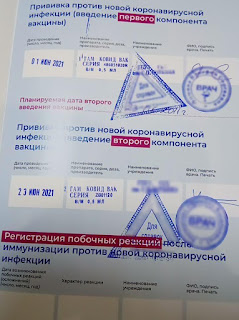Do you know who has travelled to all eleven European cities, and was present at each football game in the Euro 2020 tournament? Coronavirus. First time in the past ten weeks, coronavirus cases are rising across Europe. Is it any surprise?
Tomorrow, on 3 July, England will play Ukraine in
Rome. Yesterday, the Italian government shocked English fans holding confirmed
tickets by asking them not to come to Italy. Until 9 pm yesterday, they could
pass on their tickets to friends in Italy, or surrender them to claim a refund.
Italy has a five-day quarantine requirement. The Italian government was
confident the English fans had ignored it. Considering that England is a
potential opponent in the final for Italy, this could be strategic warfare
rather than a health measure.
Meanwhile, from tonight Portugal has imposed a
nighttime curfew. This is to discourage the gathering of young people at night,
said a cabinet minister. Portugal only recently had reopened the economy to
prepare for summer tourists. It is suggestive that the curfew was thought of
only after Portugal lost to Belgium on 27 June.
*****
Germans are furious. Yesterday, Horst Seehofer,
Germany’s interior minister said England’s plans to have 60,000+ spectators for
the semi-finals and final were “utterly irresponsible”.
Karl Lauterbach, a parliamentarian said, “UEFA is
responsible for the deaths of many people.”
All matches in Munich were played before only 14,500
fans, everyone required by German regulations to wear masks, and give a
negative test result before the match. Whereas the England-Germany match in
Wembley with 42,000 fans was the largest pandemic crowd in England. Both the
semifinals and the final will happen in London’s Wembley stadium. For the
finals, Wembley will take more than 60,000 unmasked spectators.
We have no ability to know what happens in the parallel
universe. The German criticism from ministers and health experts began after
Germany lost 0-2 to England on 29 June. Germans are not expected to lose, and
certainly not to England. Had Germany won, would any German minister have
talked about football causing deaths?
*****
This week, Scottish officials have linked 2,000 cases
to Euro 2020. Most of them had travelled to London for Scotland’s game on 18
June. Others had caught the virus at a fanzone in Glasgow or participated in a match
watching party at pubs or someone’s home.
Scotland was qualified to play in the Euro after 25
years. One can’t really blame the Scottish fans for risking attending an event
that is only slightly less frequent than a pandemic.
When Scotland-England played at an early stage of the
tournament, Scotland’s midfielder Billy Gilmour tested positive. After a
thorough health review, two players of their opponents were sent into
self-isolation. I have wondered how this contact tracing happens. Did they
replay the match on video and noted the players who came closer than six feet
to Gilmour? How was it that two English players and no Scottish player were
sent into isolation? The only possible explanation is that the three players
belong to the same club, Chelsea.
*****
Russia’s St Petersburg is hosting the Spain vs
Switzerland quarterfinal today. For each of the last three days, Russia has
posted record virus deaths. St Petersburg itself had 107 covid deaths
yesterday, a daily record for any Russian city.
Earlier, more than 300 Finnish fans returned positive
after watching matches in Russia. This was a particular tragedy since the fans
had to witness Finland losing twice in that city.
*****
Katy Smallwood, WHO’s emergency officer, said yesterday authorities must properly weigh
the public health risk. She said it was not just the crowds at the stadiums but
the mixing connected with the games. She asked several questions: Are people
travelling in crowded buses? Are they wearing masks, and maintaining distance?
What’s happening after the games? Are they going into crowded bars and pubs?
Are those not vaccinated going out to watch?
I wonder if Ms Smallwood has ever attended a football
match.
*****
There are still eight surviving teams in Euro 2020.
You can expect more criticism from countries after their team is knocked out. After the 11 July final, Europe
can announce a two week lockdown, allowing infected fans to watch the match
recordings during home isolation.
Ravi









